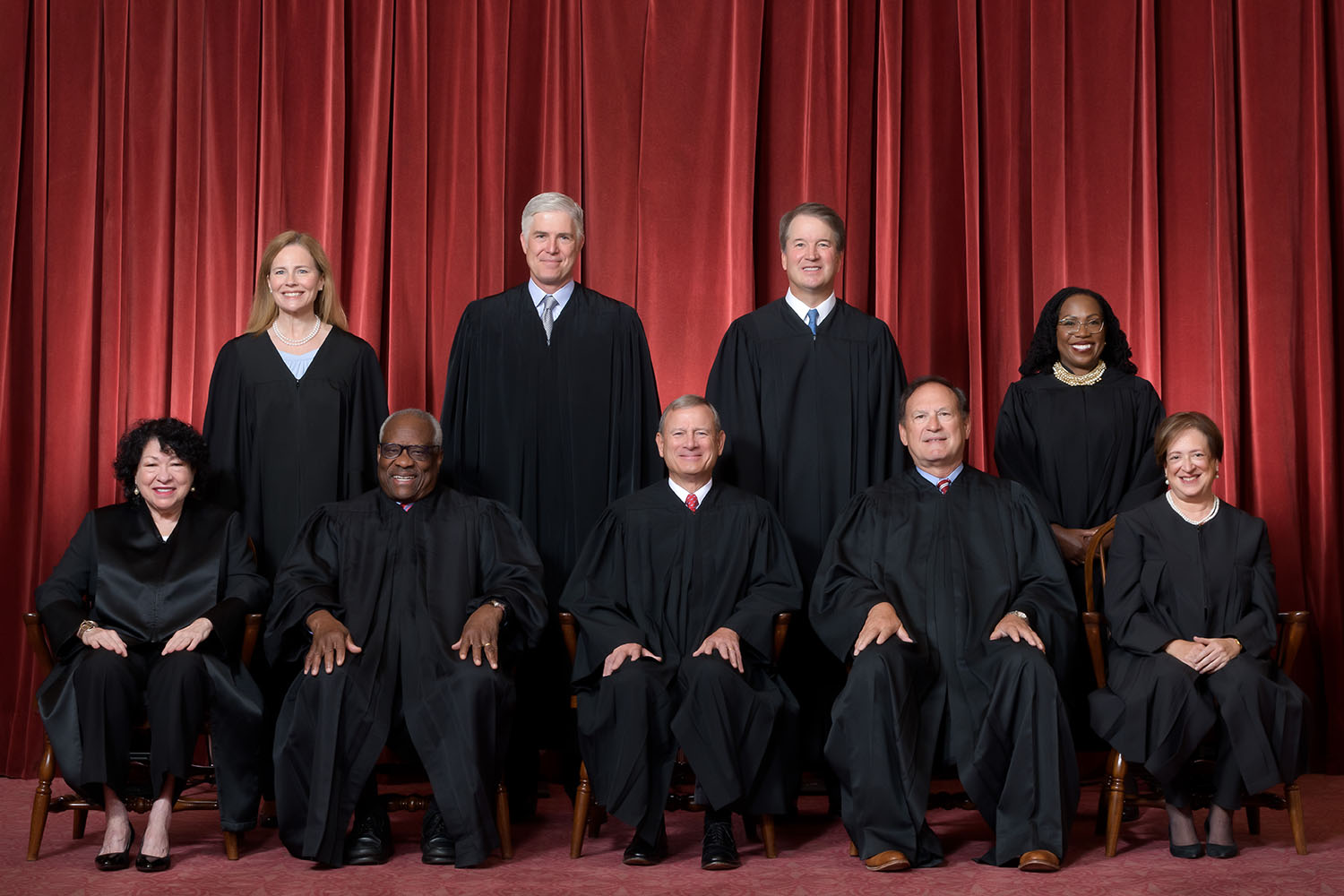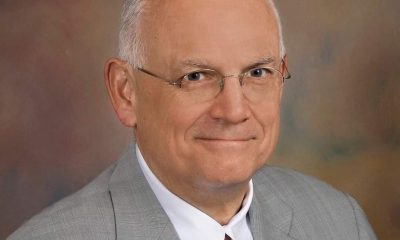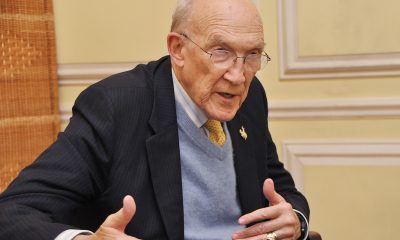U.S. Supreme Court
Supreme Court rules against affirmative action
The decision allows the U.S. Naval Academy and West Point to continue to use, at least for now, race-conscious admissions programs


By Amy Howe | WASHINGTON – In a historic decision, the Supreme Court severely limited, if not effectively ended, the use of affirmative action in college admissions on Thursday.
By a vote of 6-3, the justices ruled that the admissions programs used by the University of North Carolina and Harvard College violate the Constitution’s equal protection clause, which bars racial discrimination by government entities.
Writing for the majority, Chief Justice John Roberts explained that college admissions programs can consider race merely to allow an applicant to explain how their race influenced their character in a way that would have a concrete effect on the university. But a student “must be treated based on his or her experiences as an individual — not on the basis of race,” Roberts wrote. The majority effectively, though not explicitly, overruled its 2003 decision in Grutter v. Bollinger, in which the court upheld the University of Michigan Law School’s consideration of race “as one factor among many, in an effort to assemble a student body that is diverse in ways broader than race.”
Justice Sonia Sotomayor dissented, in an opinion that was joined by Justices Elena Kagan and Ketanji Brown Jackson. Sotomayor emphasized that the majority’s decision had rolled “back decades of precedent and momentous progress” and “cement[ed] a superficial rule of colorblindness as a constitutional principle in an endemically segregated society.”
Thursday’s ruling was the latest in a series of challenges to the role of race in university admissions. In both the North Carolina and Harvard cases, the plaintiffs had asked the justices to overrule Grutter. In her opinion for the majority in that case, Justice Sandra Day O’Connor reaffirmed that “student body diversity is a compelling state interest that can justify the use of race in university admissions,” but she warned that race-conscious admissions policies should not last forever. In 25 years, she suggested, “the use of racial preferences will no longer be necessary to further the interest” in diversity.
Eleven years after the court’s decision in Grutter, a group called Students for Fair Admissions filed the North Carolina and Harvard cases in federal court. The group was founded by Edward Blum, a conservative activist who had also spearheaded a challenge to the admissions policy at the University of Texas at Austin as well as to Shelby County v. Holder, the 2013 case that narrowed the Voting Rights Act.
After the lower courts upheld both North Carolina’s and Harvard’s admissions policies, the Blum’s group came to the Supreme Court, where it asked the justices to overrule their decision in Grutter and bar the consideration of race in university admissions altogether. The court that agreed to take up both cases last year was a very different, and much more conservative, court than the one that had upheld the UT-Austin policy seven years before. Justice Anthony Kennedy, the author of the UT-Austin decision, retired in 2018 and was replaced by Justice Brett Kavanaugh, while Justice Ruth Bader Ginsburg was succeeded by Justice Amy Coney Barrett.
In a 40-page opinion that addressed both the Harvard and UNC cases, Roberts emphasized that the Supreme Court had only allowed universities to use race-based admissions programs “within the confines of narrow restrictions.” But the Harvard and UNC programs, “however well intentioned and implemented in good faith,” Roberts explained, do not comply with those restrictions.
Both programs, Roberts began, consider race as part of their admissions program for commendable goals, such as “training future leaders in the public and private sector” and “promoting the robust exchange of ideas.” But those goals are too vague for courts to measure, Roberts reasoned.
The programs also use race in a “negative” manner, Roberts next explained, despite the Supreme Court’s admonition that “an individual’s race may never be used against him in the admissions process.” Although both universities contend that an applicant’s race is never a negative factor, Roberts wrote, “[c]ollege admissions are zero-sum. A benefit provided to some applicants but not to others necessarily advantages the former group at the expense of the latter.” Moreover, Roberts added, the programs also rely on prohibited racial stereotyping – the idea that minority students will always have the same views or perspectives on a particular issue.
Finally, Roberts observed, the Harvard and UNC programs lacked the “logical end point” suggested by Grutter: Both Harvard and UNC acknowledged that their programs do not have a “sunset” date. Indeed, Roberts noted, “UNC suggests that it might soon use race to a greater extent than it currently does.”
Roberts stressed that the court’s decision did not bar universities from ever considering race on a case-by-case basis. Schools, he indicated, can consider “an applicant’s discussion of how race affected his or her life, be it through discrimination, inspiration, or otherwise.” But programs like the ones used by Harvard and UNC, he complained, have “concluded, wrongly, that the touchstone of an individual’s identity is not challenges bested, skills built, or lessons learned but the color of their skin. Our constitutional history does not tolerate that choice.”
The majority’s decision left the door open for service academies like the U.S. Naval Academy and West Point to continue to use, at least for now, race-conscious admissions programs. The Biden administration, which filed a brief as a “friend of the court” in support of Harvard and UNC, had emphasized that senior military leaders believe that it is important to have a diverse officer corps, which in turn requires the consideration of race for admission to the service academies. But the service academies did not participate in the Harvard and UNC cases and the lower courts did not consider that argument. Therefore, Roberts indicated in a footnote, the Supreme Court did not weigh in on the issue, “in light of the potentially distinct interests that military academies may present.”
Sotomayor’s 69-page dissent emphasized that the “limited use of race” by colleges and universities “has helped equalize educational opportunities for all students of every race and background and has improved racial diversity on college campuses.” “Although progress has been slow and imperfect,” she wrote, “race-conscious college admissions have advanced the Constitution’s guarantee of equality and have promoted” Brown v. Board of Education’s “vision of a Nation with more inclusive schools.” “The devastating impact of” Thursday’s decision, she concluded, “cannot be overstated.”
Justice Elena Kagan joined Sotomayor’s dissent. Justice Ketanji Brown Jackson, who until last year served on Harvard’s board of overseers, recused herself from the Harvard case and therefore joined Sotomayor’s dissent as it applied to the UNC case. Jackson also filed a dissent in the UNC case, joined by Sotomayor and Kagan, in which she argued that American society “has never been colorblind.” “Given the lengthy history of state-sponsored race-based preferences in America,” Jackson wrote, “to say that anyone is now victimized if a college considered whether that legacy of discrimination has unequally advantaged its applicants fails to acknowledge the well-documented ‘intergenerational transmission of inequality’ that still plagues our citizenry.”
Editor’s Note: In an emailed statement, Imani Rupert-Gordon, the executive director of The National Center for Lesbian Rights (NCLR) said:
“We are deeply disappointed that the Supreme Court has once again upended decades of precedent in a decision that will deepen racial inequality in education and cause lasting harm not only to many students of color but to everyone in this country. The majority of Americans support affirmative action because it helps to level an uneven playing field caused by generations of racism and white supremacy. Today’s ruling continues to show just how out of step this Court is with our shared values. We know that when everyone has access to quality higher education, we are all better for it, and today’s ruling is a step in the wrong direction. We will continue to fight against those that seek to bring us back to a time of segregationist educational practice and policy and will not stop until all students – regardless of their race – are able to access the highest quality education in this country. NCLR is committed to working for racial equity in education for all of our communities.”
Shannon Minter, the Legal Director for NCLR in an email to the Blade after the ruling said:
“First as a lawyer in the Reagan and Bush administrations and later as a judge on the DC Circuit and now as a Supreme Court justice, Chief Justice John Roberts has sought to undermine affirmative efforts to remedy the lasting impact of slavery on Black people in our country and our nation’s long history of severe and systemic racial discrimination.
After gutting the Voting Right Act in Shelby County v. Holder, he has now succeeded in getting a majority of justices to support another of his major goals: banning college admission policies that take race into account as a factor, notwithstanding the critical importance of education as a pipeline to full participation in our society.
As the dissenting justices noted, the impact of this decision will be to worsen racial inequality in colleges and universities, which in turn will have a negative impact on all sectors of our society.
This dangerous decision could hardly come at a worse moment, when so many of our democratic norms and institutions are under attack. The only silver lining here is that this opinion is so far out of step with the values of most people in this country that its impact may be diminished by a renewed demand for greater racial inclusivity in higher education, which still may be achieved by many other means not addressed in today’s decision.
It is incumbent on all of us who care about maintaining a multi-racial democracy to do all we can to minimize the harm caused by this tragically misguided opinion.”
The White House released a statement by Vice President Harris on the Supreme Court’s ruling:
“Today’s Supreme Court decision in Students for Fair Admissions v. Harvard and Students for Fair Admissions v. University of North Carolina is a step backward for our nation. It rolls back long-established precedent and will make it more difficult for students from underrepresented backgrounds to have access to opportunities that will help them fulfill their full potential.
It is well established that all students benefit when classrooms and campuses reflect the incredible diversity of our Nation. Colleges and universities provide opportunities for students to interact with Americans from all walks of life and learn from one another. By making our schools less diverse, this ruling will harm the educational experience for all students.
Our Nation’s colleges and universities educate and train the next generation of American leaders. Students who sit in classrooms today will be the leaders of our government, military, private sector, and academic institutions tomorrow. Today’s decision will impact our country for decades to come.
In the wake of this decision, we must work with ever more urgency to make sure that all of our young people have an opportunity to thrive.”
****************************************************************************************
The preceding article was published by SCOTUSBlog and is republished with permission.
Read the ruling here:
U.S. Supreme Court
Supreme Court to hear Md. religious freedom case on Tuesday
Advocacy groups to rally outside during Mahmoud v. Taylor oral arguments

Activists on Tuesday will hold a rally in front of the U.S. Supreme Court as the justices hear oral arguments in a case that will determine whether schools are violating parents’ religious freedom by not letting them opt their children out of learning about LGBTQ-specific topics.
Mahmoud v. Taylor is a case out of Montgomery County about parents who wish to opt their children out of LGBTQ-themed lessons in public schools for religious reasons.
Montgomery County Public Schools, after initially allowing parents to opt their children out, changed the policy in March 2023.
The plaintiffs — Tamer Mahmoud, Enas Barakat, and other parents — argue “the storybooks were chosen to disrupt ‘cisnormativity’ and ‘either/or thinking’ among students.”
“The board’s own principals objected that the curriculum was ‘not appropriate for the intended age group,’ presented gender ideology as ‘fact,’ ‘sham[ed]’ students with contrary opinions, and was ‘dismissive of religious beliefs,’” according to the petition on the Supreme Court’s website.
The petition goes further, saying the parents are “not challenging the curriculum, but arguing that compelling their elementary-age children to participate in instruction contrary to their parents’ religious convictions violated the Free Exercise Clause. Construing Wisconsin v. Yoder, the 4th Circuit found no free-exercise burden because no one was forced ‘to change their religious beliefs or conduct.’”
The Coalition for Inclusive Schools and Communities, an organization that aims to bring together “advocates, educators, families, and organizations committed to inclusive, affirming, fact and science-based education,” will participate in the “Rally for Inclusive Education” rally outside the Supreme Court alongside Live In Your Truth and the Montgomery County Pride Family.
“Inclusive education isn’t just a value — it’s a necessity,” said Phillip Alexander Downie, co-chair of the Coalition for Inclusive Schools and Communities and CEO of Montgomery County Pride Family. “The right of every child to learn in an environment where they see themselves reflected, affirmed, and respected is under attack. This rally is our moment to protect that right — and ensure future generations inherit classrooms rooted in truth, equity, equality, and justice.”
The Coalition for Inclusive Schools and Communities says the rally is a “nonpartisan community gathering rooted in education, advocacy, and solidarity.”
“The focus of this event is to uplift the importance of inclusive learning environments, celebrate the power of diversity in our schools, and amplify the voices of those most impacted by exclusionary practices and rhetoric,” it said.
The rally will feature speakers from across the country, including students, educators, civil rights leaders, and authors who will give their own testimonies as to why it is important to have inclusivity in primary education. Trans Maryland, the National Women’s Law Center, MoCoPride Center, and Authors Against Book Bans are among the LGBTQ groups sponsoring the event.
U.S. Supreme Court
Supreme Court to hear conversion therapy case in October
Harmful and discredited practice is banned in 23 states and D.C.

The U.S. Supreme Court on Monday agreed to hear a case about whether state and local governments can enforce bans on anti-LGBTQ conversion therapy for children, a discredited and harmful practice that has been banned by 23 states and D.C.
The case, which will be argued in the new term that begins in October, began in Colorado Springs, Colorado where a licensed professional counselor filed a challenge to a ban in 2022, arguing the law interferes with her ability to treat patients with “same-sex attractions or gender identity confusion” who “prioritize their faith above their feelings.”
The Supreme Court in 2023 declined to hear a challenge to conversion therapy bans out of Washington state, but conservative justices Clarence Thomas, Samuel Alito, and Brett Kavanaugh voted in favor of taking up the case.
The Colorado therapist, Kaley Chiles, is represented by the Alliance Defending Freedom, which is described by the Southern Poverty Law Center as “a legal advocacy and training group that has supported the recriminalization of sexual acts between consenting LGBTQ adults in the U.S. and criminalization abroad; has defended state-sanctioned sterilization of trans people abroad; has contended that LGBTQ people are more likely to engage in pedophilia; and claims that a “homosexual agenda” will destroy Christianity and society.”
The U.S. District Court for the District of Colorado struck down Chiles’s lawsuit in 2022. Her case was appealed to the Supreme Court from the U.S. Court of Appeals for the 10th Circuit, which upheld the ban in 2023 on the grounds that it regulates professional conduct, not speech.
Human Rights Campaign President Kelley Robinson released the following statement on Monday:
“The Supreme Court’s decision to take up this case isn’t just about so-called ‘conversion therapy’ – it’s about whether extremists can use our courts to push their dangerous agenda, in an effort to erase LGBTQ+ people and gut protections that keep our kids safe. There’s no debate: so-called ‘conversion therapy’ is a dangerous practice, not therapy, and it has no place in our communities. These bans exist to protect LGBTQ+ children from harm—period.
Attacks on LGBTQ+ rights are the entry point to attacks on all of our rights. The same people trying to legalize abuse under the guise of ‘therapy’ are the ones banning books, ripping away reproductive rights, and undermining our democracy. The Supreme Court must uphold the 10th Circuit decision finding that these laws are constitutional.”
HRC added, “So-called ‘conversion therapy,’ sometimes known as ‘reparative therapy,’ is a range of dangerous and discredited practices that falsely claim to change a person’s sexual orientation or gender identity or expression.”
The group continued, “Such practices have been rejected by every mainstream medical and mental health organization for decades, but due to continuing discrimination and societal bias against LGBTQ+ people, some practitioners continue to conduct conversion therapy. Minors are especially vulnerable, and conversion therapy can lead to depression, anxiety, drug use, homelessness, and suicide.”
U.S. Supreme Court
Supreme Court will not hear challenge to Tenn. drag restrictions
Republican lawmakers limited access to “adult entertainment” in 2023

The U.S. Supreme Court on Monday declined to hear a case challenging Tennessee’s law restricting drag performances, which was enacted by Republican state lawmakers in 2023.
The Tennessee Adult Entertainment Act forbids “adult-oriented performances” that take place in public or where they may be seen by minors. Legislators specified the legislation was meant to target drag shows.
A judge on the U.S. District Court for the Western District of Tennessee ruled that the law was “unconstitutionally vague and substantially overbroad,” allowing drag performances to continue in parts of the state. The 6th U.S. Circuit Court of Appeals reversed the decision in July, however, ruling that the theater company that filed the complaint lacked standing to sue.
President Donald Trump said that his decision to name himself chair of the Kennedy Center shortly into his second term came at least partially in response to the iconic performing arts center’s history of hosting drag shows, which he called “anti-American propaganda.”
-

 State Department5 days ago
State Department5 days agoHIV/AIDS activists protest at State Department, demand full PEPFAR funding restoration
-

 Brazil5 days ago
Brazil5 days agoUS lists transgender Brazilian congresswoman’s gender as ‘male’ on visa
-

 District of Columbia5 days ago
District of Columbia5 days agoCapital Pride wins $900,000 D.C. grant to support WorldPride
-

 Obituary4 days ago
Obituary4 days agoLocal attorney, LGBTQ rights advocate Dale Sanders dies at 75











